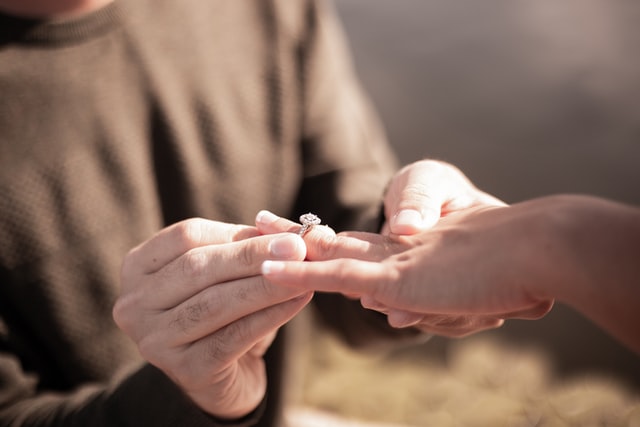
Thus, you have chosen, you will ask the one you love to wed you. Congrats! There are such countless brilliant gemstones to browse, knowing where to begin can be an overwhelming encounter!
There are numerous viewpoints to making a custom ring, the initial segment to consider is what gemstone you ought to pick. Here are our main 10 gemstones that are the most ideal to engagement rings:
Gemstone Choice 1: Diamond
There is a justification for why precious stone is number one on this rundown! With a Mohs’ Scale of Hardness of 10. This gemstone is the hardest material on Earth. This implies it won’t ever scratch, as just a precious stone can scratch another jewel. Jewels are perfect for engagement rings since they are really strong. In addition to the fact that they are hard (won’t scratch) yet they are likewise exceptionally extreme (impervious to breaking). Obviously, jewel is the most exemplary stone for engagement rings in Vancouver, as they address the immaculateness and never-ending component of affection and responsibility.
Every one of the precious stones we sell at Condesa Jewelry Expertise are morally obtained and recorded under the Kimberly Process.
Gemstone Choice 2: Blue Sapphire
Blue sapphire is our number two pick. With a Mohs’ Scale of Hardness of 9, sapphires are exceptionally impervious to scratching. Their immortal magnificence makes them an incredible focus stone for engagement rings. Whether alone as a solitaire or emphasized with jewels, blue sapphire brings a profundity of variety and innovation to your engagement ring. Blue sapphires are mined in many regions of the planet including Sri Lanka, Australia and Montana. They are for the most part cut as faceted rounds, ovals or pears but on the other hand are cut as extravagant shapes and cabochons.
As a side note, sapphires come in all tones, not simply blue! The main variety of sapphire you won’t find is red – as that is ruby.
Gemstone Choice 3: Ruby
The dark red of a ruby is unrivaled by some other gemstone. As a middle stone for an engagement ring, this one is unprecedented. With a Mohs’ Hardness of 9, a ruby is very hard and will keep going for ages without scratching. Whether alone as a solitaire or emphasized with jewels, a ruby carries a practically basic component to your engagement ring. Rubies are mined in many regions of the planet including Sri Lanka, India, Eastern Africa, Vietnam, Thailand and most broadly Burma (Myanmar). They are for the most part cut as faceted rounds, ovals or pears but on the other hand are cut as extravagant shapes and cabochons.
Certain rubies present a normally happening six-pointed star which makes for an additional unique engagement ring.
Gemstone Choice 4: Emerald
No rundown of engagement ring pearls would be finished without Emerald. Its dark green tone and even its name evoke a picture and sensation shared across societies. The dark green beryl has a tackle of 7.5, making it very impervious to scratching and exceptionally shiny. Not at all like different diamonds, emeralds present a nursery of regular considerations that add to the independence of each stone. As a solitaire or complemented with precious stones, an emerald engagement ring has an immortal polish. The very special considerations that add to the appeal of emerald likewise make the stone more inclined to crack. Consequently, the middle stone should be set in a very much shielded ring setting to safeguard it from influence.
Exceptional consideration should be taken while adjusting an emerald ring so as not to lose the normal cedar oil filler with which practically all emeralds are dealt with.
Gemstone Choice 5: Tsavorite
Frequently, when clients are searching for a green stone for an engagement ring for an exceptionally dynamic individual, I will suggest tsavorite as an emerald substitute. Mined in Eastern Africa, this dark green individual from the garnet family has a Mohs’ Hardness as emerald (7.5).
It is quite often liberated from considerations which makes it substantially less inclined to crack than emeralds. It likewise is very reasonable in bigger sizes and is cut in exceptionally exact and clear cut features. I’ll wager you were thinking “hello, aren’t garnets red?” The truth is that the term garnet alludes to an enormous gathering of gemstones that is partitioned into six species. Tsavorite is important for the grossular types of garnet.
Gemstone Choice 6: Tanzanite
Found in 1967 by a Masai tribesman, this violet, purplish-blue gemstone turned into a hit. Tanzanite is a kind of zoisite with a Mohs’ Hardness of 7, making it very scratch safe. This stone was made well known by Tiffany and Co. in the last part of the 1960’s; to such an extent that for some time it was more sought after than sapphire.
Tanzanite is accessible in a wide assortment of cuts and minor departure from its variety tones settling on it a pleasant decision for an assortment of engagement rings.
Two exceptionally fascinating realities about tanzanite: it is found in just a single area of Northern Tanzania known as the Merelani Hills. It is pleochroic, meaning it shows three unique tones when seen every which way.
Gemstone Choice 7: Alexandrite
Alexandrite is an exemplary extraordinary gemstone. Frequently portrayed as emerald by day and ruby around evening time, this sort of chrysoberyl shows red under brilliant light and green under colorific lighting.
Moreover, this gemstone is incredibly hard with a Mohs’ of 8.5, which settles on it as an extraordinary decision for an engagement ring focus stone.
As you might have speculated, the revelation of this gemstone in 1830 created all in all a ruckus in Imperial Russia since red and green were the shades of the domain. The stone was in this way named after Alexander II who was, at the time the beneficiary of the Russian privileged position and would proceed to become Tzar.
Gemstone Choice 8: Moonstone
As an elective engagement ring focus stone, moonstone, with its trademark adularescence is a pleasant pick for an exceptional plan. It has a Mohs’ Hardness of around 6.5, and hence, is still rather scratch safe. For the surging blue peculiarity to be seen, moonstone should be cut in a cabochon and is best set in a bezel.
Like all individuals from the feldspar species, the peculiarity of light-play is brought about by infinitesimally slight layers of material that structure this gemstone. Many societies have related moonstone with the twilight, similarly as not surprisingly.
Gemstone Choice 9: Yellow Sapphire
Adding a yellow place stone into an engagement ring makes for something extremely unique. Yellow sapphire is an extraordinary choice for this. Very much like all corundum (the pearl species that incorporates sapphires and rubies), yellow sapphire has a Mohs’ Hardness of 9, making it incredibly scratch safe.
Yellow sapphires are mined essentially in Sri Lanka, yet can likewise be tracked down in Tanzania, Madagascar, Australia and Thailand. Their variety of immersion can go from pale to extreme yellow and they are cut in all shapes and sizes both faceted and cabochon.
Gemstone Choice 10: White Sapphire
White sapphire is our gemstone of decision for the client who needs a white gemstone, that isn’t a jewel. More reasonable than jewel and yet totally regular (in contrast to cubic zirconia or moissanite), white sapphire has a Mohs’ Hardness of 9 and has first class brilliance. White sapphire can be set in a wide range of engagement rings similarly as precious stones.
They are most frequently cut in faceted round or oval shapes giving a scope of choices as focus stones. Of the relative multitude of choices for subbing jewels, white sapphire is the awesome and most strong normal choice.




